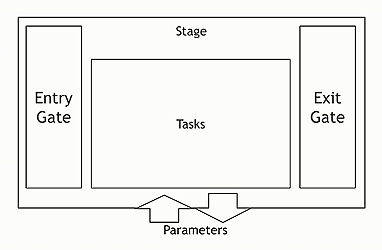Examples of stages are development (Dev), QA, user acceptance test (UAT), preproduction, and production. These stages typically map closely to the environments where applications or microservices are to be deployed.
Each stage consists of one or more entry gate rules, one or more exit gate rules, and the automation tasks to complete the stage.

-
Entry gate rules ensure all the checks and balances are met before tasks in that stage can begin
-
Exit gate rules allow you to control when a pipeline can exit a stage and what approvals are needed.
-
Tasks contain the automation logic. This is where you specify what to do.
For example, if your stage is a test stage, it contains the tasks that must be executed to ensure that the test automation for your software delivery process is successfully completed.
-
Parameters can be created for various objects and automation tasks in the stage. This makes the pipeline reusable, allowing orchestration of the inputs and outputs for the stage and of the properties passed between stages.
-
Run if conditions, Wait until conditions, and wait dependencies can be set on pipeline objects. See Pipeline Objects and Conditions for more information.
-
Wait conditions can be set for triggered pipelines, triggered releases, and specific pipelines and pipeline objects. See Hierarchical Pipelines and Releases for more information.